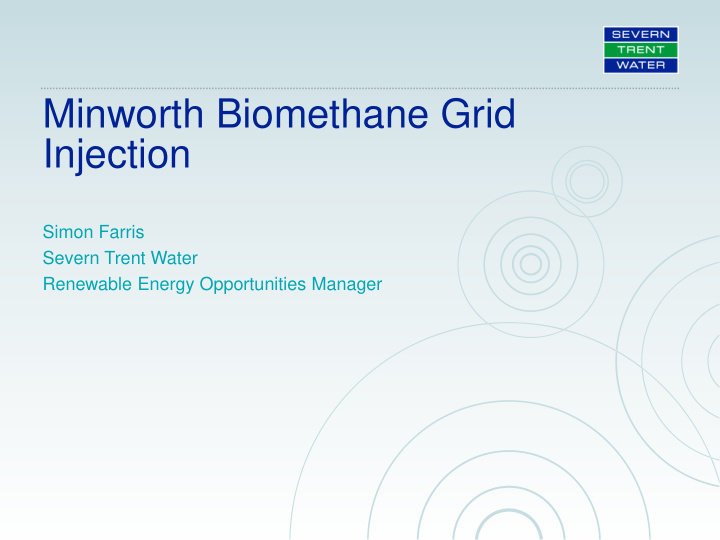



Minworth Biomethane Grid Injection Simon Farris Severn Trent Water Renewable Energy Opportunities Manager
Severn Trent Water Renewables Who are we? Many people will recognise Severn Trent Water as a leading Water and Waste Service Utility − 100,000 km of underground pipes − 7,000 above ground assets − Serving 4.2 million properties and businesses − Publically owned FTSE 100 Company Renewable Energy Generation is a rapidly expanding side to our business − In 2014/15 we generated 250 GWh of electricity – 28% of the company usage − This was achieved through a combination of: • Sewage Sludge Anaerobic Digestion • Crop AD • Food Waste AD (Dec 2014) • Hydro Generation • Wind Power (Summer 2014) − Target is to reach 50% by 2020
We have 53 MW of generation plant distributed across our region Sewage gas AD with CHP or BtG 55 engines & 1 Water Scrubber on 34 sites (36.5 MW) Crop gas AD & CHP 3 engines on 1 site (3.1 STAUNTON HAROLD MW) NEWTOWN Coleshill (FWAD AD) Wind Power HYDRO 4 turbines on 3 sites 6 turbines on 4 sites (10 MW TIC) (1.5 MW) Food Waste AD & CHP 2 engines on 1 site(2.1 MW) 3
Minworth
Why Biomethane to Grid? • The anaerobic digestion process at Minworth produces a substantial amount of biogas c. 3500 Nmch • When the heat is not required, relative energy conversion is low • The connection to the electricity grid is restrictive • Government incentivised form of generating energy • Very well established technology in Europe, now becoming a major UK market • Biogas upgrading has allowed Minworth to expand and diversify the energy it can produce Relative Energy Production Efficiencies 100% 80% 60% 40% 20% 0% CHP - No CHP - Heat Gas Export Heat Use Used
Minworth Process Overview – Upgrading Sewage Gas The Process Operates 4 main process steps Flow to the National Gas Grid
Propane Supplementing Why do we need it? • The gas must be tested it to prove it meets all of the Gas Safety (Management) Regulations before it can pass into the network. • Methane cannot meet these requirements on it’s own, it needs a little help. CV 39.5 39 National Grid 38.5 Target 38 MJ/scm 37.5 37 36.5 36 35.5 35 Low methane High Methane With Propane quality quality
Removing Propane How have we reduced the need? NG remote Monitoring point West Midlands Local Transmission System (High Flow) Biomethane STW Grid Plant Entry Unit Propane
Why remove Propane? Why is this worth it? • Connecting to the local transmission system is substantially more expensive • The Propane Cost savings pay for this in 2-3 years • The Carbon footprint of the plant is substantially lowered • It is Cheaper, Cleaner and Simpler
How are we able to do this The development of this solution has required a number of stakeholders to agree • National Grid – Installing of Remote Monitoring point and agreement of operating principles • Ofgem – Agreement of methods of operation on site • CNG Services – Design of control system and operating principles • Imtech Process – Management of Supply Chain to deliver the right process equipment and control management systems • Severn Trent Water – Prepared to manage risks, operate, and utilise innovative process
Where we are today The Plant was commissioned on the 25 th September 2014 • The plant has now operated for approximately 9 months • We have produced 38 GWh of renewable gas for Grid Injection – enough to heat around 2500 UK homes for a year • Gas production is both stable in terms of it’s Quality and Quantity − We inject around 19,000 scm of gas each day − The gas is typically between 36.7 and 37.1 MJ/m 3 every day • Plans to expand our generation capability through Advanced Digestion • Currently developing future sites to increase generation as a business
Recommend
More recommend